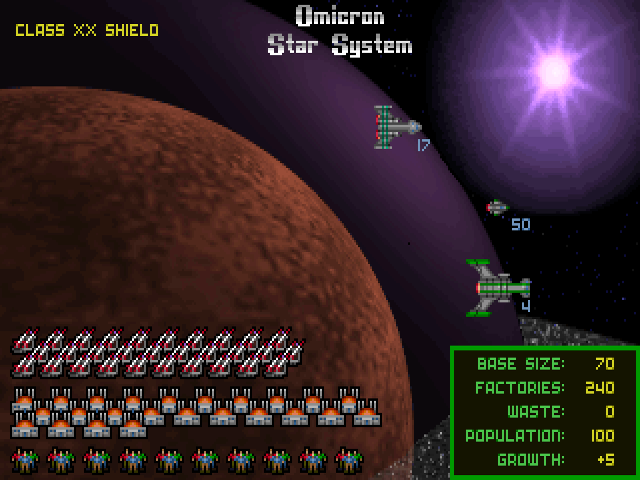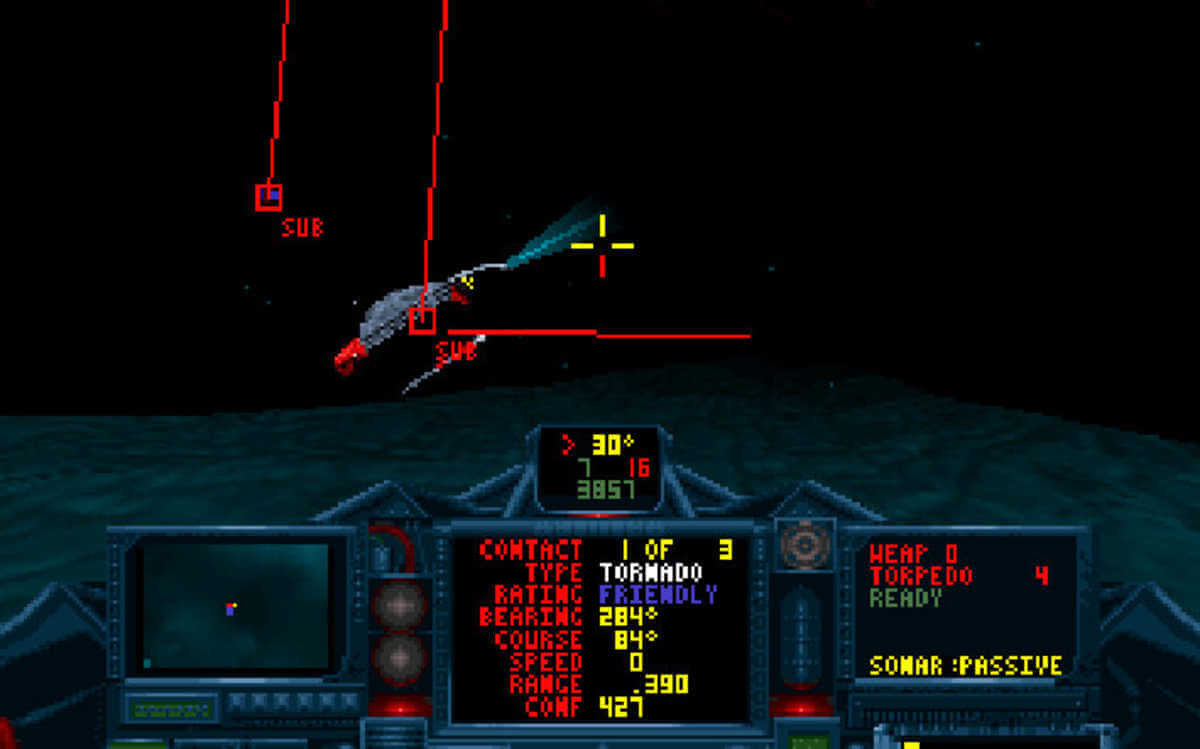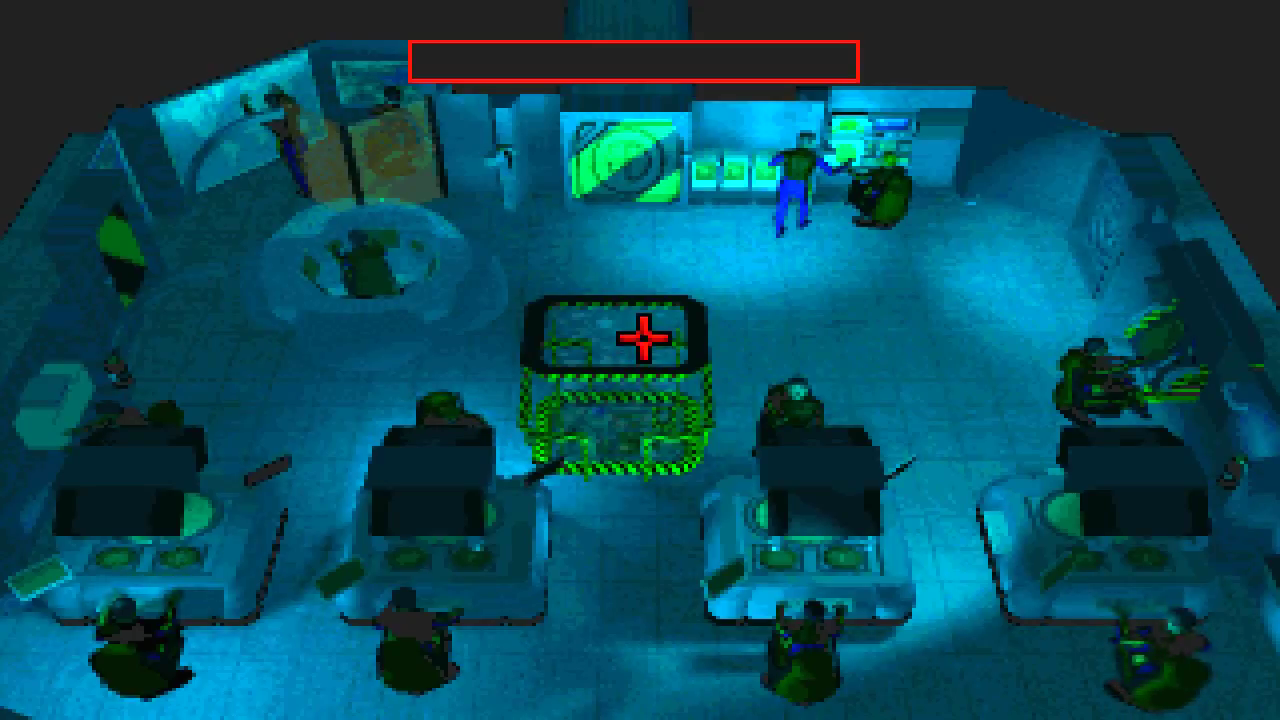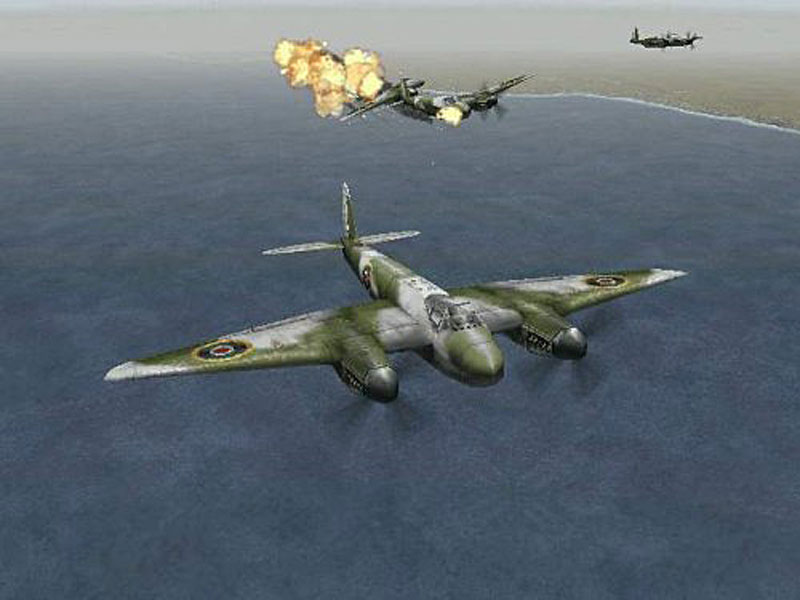 MicroProse Software - Part 3
MicroProse Software - Part 3
The Spectrum Holobyte Years (1993-1998)
1993
 Stealey had given Gilman Louie’s Spectrum Holybyte company a $500,000 advance in December of 1991 when Spectrum’s primary investor, Brit Robert Maxwell was found drowned off the coast of Spain. Stealey called Gilman in May of 1993 for return help. Stealey was trying to overcome a cash crunch from the lack of new games in 1992 and called Gilman to bring his Venture Capital Group, Kleiner, Perkins, Caufield & Byers to the rescue of MPS. Kleiner bought enough stock of MicroProse to take control of the MPS Board and install Mr. Louie as the new CEO, in June 1993. Steve Race became the new head of the company.
Stealey had given Gilman Louie’s Spectrum Holybyte company a $500,000 advance in December of 1991 when Spectrum’s primary investor, Brit Robert Maxwell was found drowned off the coast of Spain. Stealey called Gilman in May of 1993 for return help. Stealey was trying to overcome a cash crunch from the lack of new games in 1992 and called Gilman to bring his Venture Capital Group, Kleiner, Perkins, Caufield & Byers to the rescue of MPS. Kleiner bought enough stock of MicroProse to take control of the MPS Board and install Mr. Louie as the new CEO, in June 1993. Steve Race became the new head of the company.
MicroProse UK was forced to close its two satellite studios in northern England and dispose of over 40 staff at its Chipping Sodbury head office (MicroProse Chipping Sodbury). A core group of artists, designers, and programmers left MicroProse UK to join Psygnosis, which opened an office in Stroud specifically to attract ex-MicroProse employees.
Stealey left the Board of Directors in the fall of 1993 to retire. He later commented, “Spectrum Holobyte had a lot of cash and very few products. MicroProse had a lot of products and no cash. It was a great marriage, but the new company only needed one chairman, so I resigned.”
Master of Orion was introduced in 1993, developed by Simtex in Austin, TX.
Subwar 2050 was another pretty incredible title MicroProse released this year. Taking their knowledge from the flight sim and strategy genres, and moving it all below the oceans, it was slower-paced and had a rather unique mix of action and strategy.
Other titles from this year include Pirates! Gold, Sid Meier's Railroad Tycoon Deluxe, Starlord, BloodNet, The Chaos Engine, Dogfight, Fields of Glory, Return of the Phantom and Machiavelli: The Prince.
Two more expansions for Falcon 3.0 arrived in 1993 with Hornet and MiG-29.
1994
 In 1994, MicroProse launched their latest combat flight simulator, Fleet Defender. Scott Elson recalls about the development: "Part of the plan with Fleet Defender was to really improve the dogfighting AI since that hadn’t changed much over the last few games. This was really a dream shot for me because I had wanted to make various improvements to the AI since playing F-19 in college. I bumped the maximum number of planes that could be active from 8 (with only 4 of those being enemy) to 70 and all planes would be active in the game from the beginning unless the spawning made sense, like planes taking off from a runway after the game had been running for a bit. (Note: I think I’ve mentioned 80 planes in the past but looking at screen shots in the strategy guide of the mission builder I can see a limit of 70 planes, 60 ground targets, 40 paths, 85 waypoints and 130 actions.)
In 1994, MicroProse launched their latest combat flight simulator, Fleet Defender. Scott Elson recalls about the development: "Part of the plan with Fleet Defender was to really improve the dogfighting AI since that hadn’t changed much over the last few games. This was really a dream shot for me because I had wanted to make various improvements to the AI since playing F-19 in college. I bumped the maximum number of planes that could be active from 8 (with only 4 of those being enemy) to 70 and all planes would be active in the game from the beginning unless the spawning made sense, like planes taking off from a runway after the game had been running for a bit. (Note: I think I’ve mentioned 80 planes in the past but looking at screen shots in the strategy guide of the mission builder I can see a limit of 70 planes, 60 ground targets, 40 paths, 85 waypoints and 130 actions.)
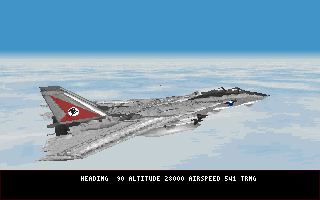

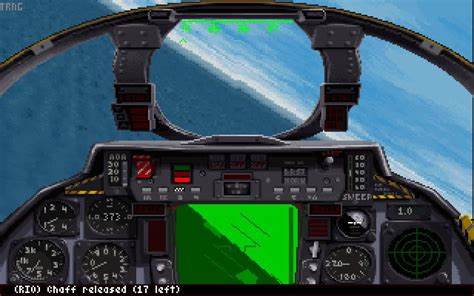
Fleet Defender in 256-colour VGA
This was a pretty drastic change which caused some concerns eventually leading to another programmer stopping by to tell me all the AI stuff going on was hurting the framerate. I told him I had been trying to be really careful about that but we could take a look at it. Luckily I had set up a key to pause just the AI activity so I could test things. Bringing up a mission with a bunch of AIs I showed him what the rate was and then hit the key and the number didn’t change. He agreed it wasn’t me and after that people weren’t as worried.
The graphics engine was another area where there were some great improvements. Between F-15 III and FD, Scott Spanburg added texture mapping and tiled textured terrain. Also he and John Paquin, who was working on the Pacific Air War (PAW) graphics engine, were trading information back and forth. John had come up with a really cool system where planes could fly apart when destroyed. I remember hearing some questions about trying to bring it over to FD but people pointed out that since FD was coming out first and the PAW group got it working it wouldn’t be right to steal their thunder. I thought that was a proper decision."
 Another great flight sim from MicroProse this year was 1942: The Pacific Air War. Set during World War II during the battle between the US and Japan, the game features 10 accurately modelled aircraft and you can play either on the US side or the Japanese.
Another great flight sim from MicroProse this year was 1942: The Pacific Air War. Set during World War II during the battle between the US and Japan, the game features 10 accurately modelled aircraft and you can play either on the US side or the Japanese.
Not only can you take part in a variety of missions in the two included campaigns, you can also take on the role of a General to plot out where units are to be situated. At any time in the game you can then take over flying any plane on the map, or if you choose, fly none of them and watch the battle unfold before you on the map.
Unlike previous combat sims from MicroProse, this one emphasized realism, to the point where the aircraft will behave just like the originals did in the war - watch out for lack of manoeverability at low speeds, go easy on the ammo as there's no indicator to tell you how much you have left, and watch your engine temperatures. The AI opponents are actually fed "stick and rudder" commands!

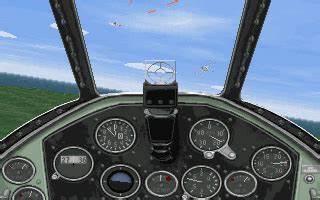
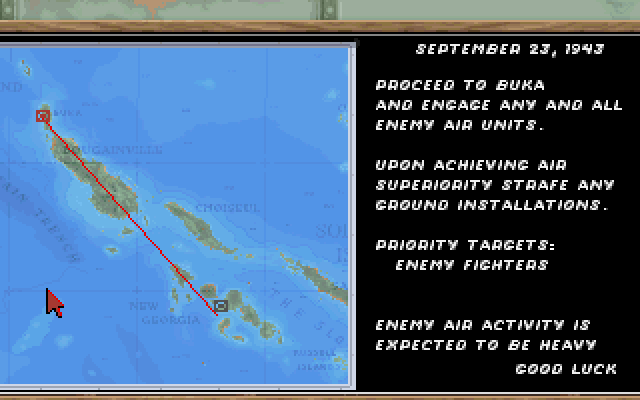
1942: The Pacific Air War in 256-colour VGA
More titles came along in 1994 including Colonization, Transport Tycoon, Master of Magic - developed by Simtex in Austin, TX., XCOM: UFO Defense, Pizza Tycoon, Subwar 2050: The Plot Deepens, CyberStrike, SpaceKids and Dragonsphere.
1995
In 1995, MicroProse released Across the Rhine, Grand Prix Manager, Star Trek: The Next Generation - A Final Unity (not developed at Hunt Valley), Transport Tycoon Deluxe and Transport Tycoon World Editor, XCOM: Terror from the Deep and Virtual Karts.
A scenario disk was released in 1995 for 1942: The Pacific Air War, simple called 1942: The Pacific Air War: Scenario. This added lots of new features such as the ability to join the American or Japanese side, which opened up six new land-based planes: the P-38 Lightning, the P-40 Warhawk and the P-51 Mustang for the Americans, and the Ki-61 "Tony", the Ki-84 "Frank" and the N1K "George" for the Japanese. Also included in the scenario disk were two new theatres of war with missions in the Philippines and New Guinea. Finally, a modem play option was added which catered for two players to fly cooperatively or go head-to head in more than 200 missions specially designed for multiplayer. This scenario disk was bundled with the original game in a compilation CD called 1942: The Pacific Air War Gold.
A scenario disk was also released in 1995 for Fleet Defender. This included adding a graphical mission builder and new theaters and campaigns. There was another group that was working on the “Gold” version (a bunch of multimedia stuff and a Windows front end, as well as the original game and the scenario disk). Scott "Elf" Elson recalls, "I think I was the only person on the scenario disk full time though one of the artists might have been also.". Ned also worked on this. He goes on to say "One of the things I had to do for the scenario disk was create all the missions. George Wargo, our consultant who was an F-15 pilot, gave me a great head start by creating the mission tree with the basic mission description. He had consulted on F-15 III and so was familiar with game development and working with the team which was a big advantage and while his background was with the Air Force a lot of stuff was the same.
Anyway, back to the missions. Since we were going to include a mission builder with the scenario disk I got that working first. In the original game the missions were created with a text file which made things much harder since it was difficult get a feel for the overall picture and easy to miss when you mistyped something. In both cases though we’d come up with a template that would have air defenses and possibly some default CAPs that we could use as a basis for each mission. Remember this trick; we’ll come back to it later.
One week I set myself a goal of trying to do all the Korean campaigns in 5 days (might have been just one campaign but I’m pretty sure the goal was all). Not in a finished/ship it state but good enough that hopefully QA would just want some tweaks.
1996
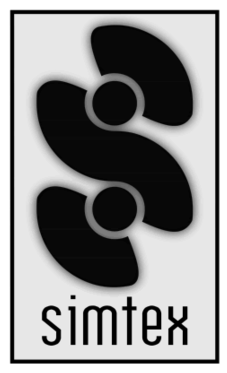 In 1996, Spectrum HoloByte started cutting a majority of the MicroProse staff in order to reduce costs. These cuts and bad corporate policies by then-owner, Spectrum Holobyte, led to Sid Meier, Jeff Briggs and Brian Reynolds leaving and forming Firaxis Games the same year.
In 1996, Spectrum HoloByte started cutting a majority of the MicroProse staff in order to reduce costs. These cuts and bad corporate policies by then-owner, Spectrum Holobyte, led to Sid Meier, Jeff Briggs and Brian Reynolds leaving and forming Firaxis Games the same year.
Also in 1996, Spectrum HoloByte/MicroProse bought out Simtex, earlier a developer of MicroProse-published bestsellers Master of Orion and Master of Magic. Simtex was re-branded as MicroProse Texas. MicroProse closed these offices shortly after.
Other games followed in 1996 including Civilization II, Grand Prix 2, Grand Prix Manager 2, and Master of Orion II: Battle at Antares (developed at MicroProse Texas in Austin, TX.). Also Top Gun: Fire at Will and Track Attack.
1997
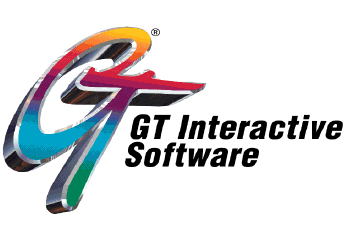 On 1st October 1997, Spectrum Holobyte announced they would change their name to MicroProse, with all of Spectrum Holobyte's products being consolidated under the MicroProse banner. Spectrum HoloByte Japan was one of their subsidiaries and eventually became MicroProse Japan K.K. Their Chipping Sodbury, England, subsidiary became MicroProse Ltd. (aka MicroProse-Spectrum HoloByte UK-Europe) and their German division was renamed MicroProse-Spectrum Holobyte GmbH. Four days later, the new MicroProse announced they were to be acquired by GT Interactive Software for $250 million.
On 1st October 1997, Spectrum Holobyte announced they would change their name to MicroProse, with all of Spectrum Holobyte's products being consolidated under the MicroProse banner. Spectrum HoloByte Japan was one of their subsidiaries and eventually became MicroProse Japan K.K. Their Chipping Sodbury, England, subsidiary became MicroProse Ltd. (aka MicroProse-Spectrum HoloByte UK-Europe) and their German division was renamed MicroProse-Spectrum Holobyte GmbH. Four days later, the new MicroProse announced they were to be acquired by GT Interactive Software for $250 million.
After the announcement MicroProse’s stock price reached $7 a share. GT Interactive expected the deal to be completed by the end of that year, but 2 months after, on 5th December, GT Interactive pulled the plug on the deal with rumours about MicroProse's financial situation being worse than anticipated. According to both CEOs “the time is simply not right” for the deal. MicroProse’s stock plummeted to just $2.31 after the announcement of the deal’s cancellation. According to Computer Gaming World, the merger was annulled due to a “fundamental” disagreement over how the joint company would be writing off its research and development costs, as MicroProse insisted on retaining their policy of paying off the developer immediately.
In November 1997, MicroProse was sued by both Avalon Hill (who had the U.S. publishing rights to the name Civilization) and Activision for copyright infringement. MicroProse responded by buying Hartland Trefoil, which was the original designer and manufacturer of the Civilization board game, and then sued Avalon Hill and Activision for trademark infringement and unfair business practices as a result of Activision’s decision to develop and publish Civilization video games. Because Hasbro was negotiating the acquisition of both Avalon Hill and MicroProse, the lawsuits were settled in July 1998. Under the terms of the settlement MicroProse became the sole owner of the rights of the name Civilization and Activision acquired a license to publish a Civilization video game which was later titled Civilization: Call to Power.
Their 1997 game list included Worms 2, XCOM: Apocalypse, Dark Earth, Magic: The Gathering and Star Trek: Generations.
The first expansion to Magic: The Gathering was also released the same year entitled Magic: The Gathering - Spells of the Ancients.
1998
 On 12th August 1998, Hasbro Interactive announced they would be purchasing MicroProse. In preparation for this, MicroProse shut down the ex-Simtel offices in Austin, TX in June. On 14th August, Hasbro issued a $70 million cash tender offer to purchase all MicroProse’s shares for $6 each. This deal was completed on 14th September, when Hasbro bought 91% of MicroProse’s shares and announced that MicroProse had become a wholly owned subsidiary. The remaining shares would also be acquired for $6 in cash. At the time of Hasbro’s acquisition, MicroProse had 343 employees, including 135 at Alameda, California (MicroProse Alameda), with a total operating cost of $20 million per year. Besides the development studio in Alameda, MicroProse had three other studios: Hunt Valley, Maryland (MicroProse, Hunt Valley); Chapel Hill, North Carolina; and Chipping Sodbury, England.
On 12th August 1998, Hasbro Interactive announced they would be purchasing MicroProse. In preparation for this, MicroProse shut down the ex-Simtel offices in Austin, TX in June. On 14th August, Hasbro issued a $70 million cash tender offer to purchase all MicroProse’s shares for $6 each. This deal was completed on 14th September, when Hasbro bought 91% of MicroProse’s shares and announced that MicroProse had become a wholly owned subsidiary. The remaining shares would also be acquired for $6 in cash. At the time of Hasbro’s acquisition, MicroProse had 343 employees, including 135 at Alameda, California (MicroProse Alameda), with a total operating cost of $20 million per year. Besides the development studio in Alameda, MicroProse had three other studios: Hunt Valley, Maryland (MicroProse, Hunt Valley); Chapel Hill, North Carolina; and Chipping Sodbury, England.
 In October 1998 MicroProse released the sequel to 1994's 1942: The Pacific Air War, entitled European Air War. This gap of 3-4 years was necessary to rework the graphics engine used by its forebear.
In October 1998 MicroProse released the sequel to 1994's 1942: The Pacific Air War, entitled European Air War. This gap of 3-4 years was necessary to rework the graphics engine used by its forebear.
It was a combat flight simulator set in the Battle of Britain and the Allied air offensives in Western Europe during 1943-1945.
The Pilor Career mode allows you to become a pilot in the RAF, Luftwaffe or USAAF. As you progress through your career by succeeding in a variety of missions, you are promoted which, among other things, gives you more control of other planes in your squadron.
There are 20 flyable aircraft with authentic cockpits and flight models, including the P-51 Mustang, P-38 Lightning, P-47 Thunderbolt, Supermarine Spitfire, Hawker Hurricane, Tempest, Typhoon, Focke-Wulf Fw-190, Messerschmitt Bf-109, Bf-110, and Me-262.
Work had begun on the game back in 1995, but in 1996 part of the development team left, and a second team took over. This apparently caused some existing bugs to not get fixed, but under the new team brand new features were added that were not originally planned.
Another flight simulator of note, Falcon 4.0 finally arrived in 1998. The game had been in development by Spectrum Holobyte since 1992!
Other 1998 titles include M1 Tank Platoon II, Mech Commander, Star Trek: The Next Generation - Klingon Honor Guard, XCOM: Interceptor, Nightlong: Union City Conspiracy, Top Gun: Hornet's Nest and Ultimate Race Pro.
The second expansion to Magic: The Gathering was also released the same year - Magic: The Gathering - Duels of the Planeswalkers
1999
On 7th December 1999, Hasbro shut down the MicroProse offices at Chapel Hill Studio, NC, and Alameda Studios, CA. This led to XCOM: Genesis being cancelled.
Rollercoaster Tycoon and its first expansion, Corkscrew Follies was launched, as were Star Trek: The Next Generation - Birth of the Federation, Worms Armageddon, GP 500, Grand Prix World, Spirit of Speed 1937, Mech Commander Gold and MechWarrior 3 and its expansion Pirate's Moon.
2000
In December 2000, the French software company Infogrames announced plans to buy Hasbro Interactive, which included all the old MicroProse and Spectrum Holobyte businesses. This was in light of a very poor 1999 which saw Hasbro's shares drop 70% and them posting their first net loss in 20 years. The deal was completed for $100 million in January 2001.
The year 2000 brought us B-17 Flying Fortress: The Mighty 8th - the last MicroProse game to be developed under Hasbro, Grand Prix 3, Rollercoaster Tycoon got its second expansion, Loopy Landscapes, Majesty: The Fantasy Kingdom Sim and Risk II.


